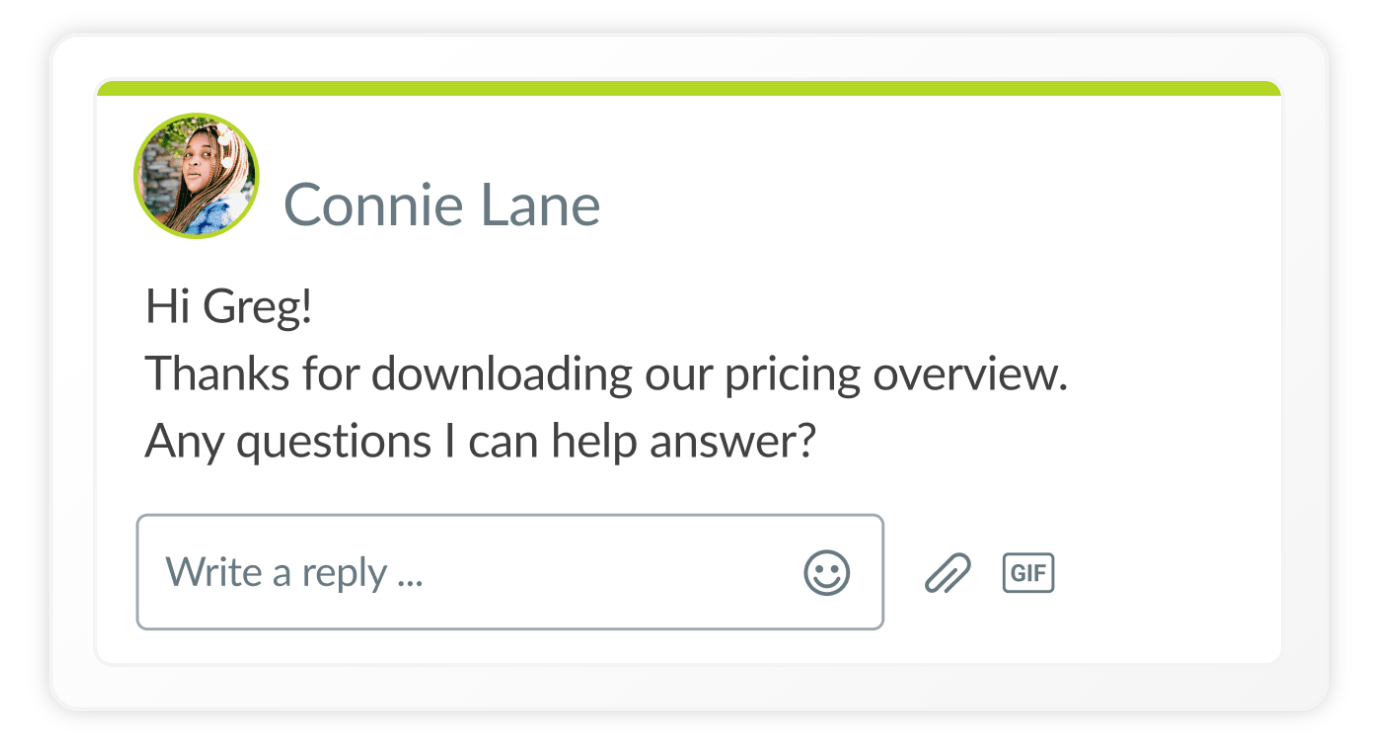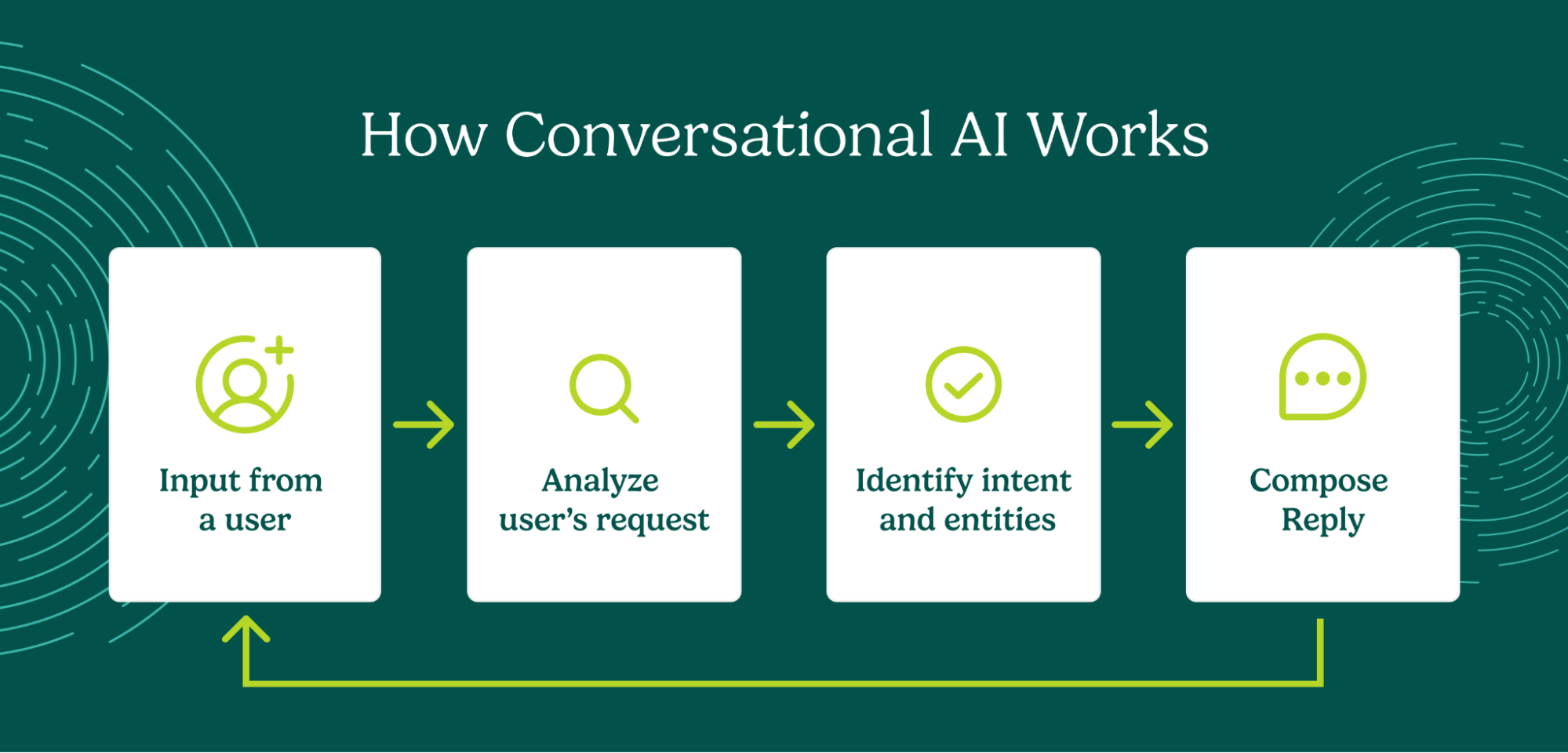The Beginner’s Guide to Conversational AI
Conversational AI is transforming the way businesses engage buyers, delivering instant, relevant interactions that keep leads moving through the sales funnel. Learn how AI-powered chatbots and automation can enhance engagement, qualify leads, and drive revenue.
Scattered conversations, missed connections, and lost momentum—these challenges often stem from a lack of real-time engagement.
Today’s buyers expect instant, relevant interactions. When they struggle to find the right information or face delays in connecting with sales, interest fades, and opportunities slip away. Sound familiar?
If your business isn’t meeting buyers where they are, you’re not just losing efficiency, you’re losing their attention. But with conversational AI, you can engage prospects at the right moment, deliver the insights they need, and seamlessly guide high-intent leads to sales.
What is conversational AI?
Conversational AI is technology that allows machines to understand and respond to human language in a way that feels natural. It powers chatbots, voice assistants, and automated messaging systems that do more than just follow scripts – they recognize context, pick up on intent, and keep conversations moving.
These systems provide instant answers, guide users through tasks, and even hand off complex issues to a human when needed. The goal isn’t to replace real conversations but to make them easier, smoother, and less frustrating for both customers and businesses.

How conversational AI works
You don’t need to have a PhD in natural language programming (or even be a programmer) to implement conversational AI into your marketing strategy. Breaking it down, conversational AI follows four steps:
- Understanding the message – First, the AI breaks down what the user is saying. It looks at the words, the context, and even the tone to figure out the intent behind the message. Is the user asking a question? Giving a command? Looking for recommendations? This step is crucial because a conversational AI is only as good as its ability to truly "get" what the user means.
- Processing the request – Once the AI understands the intent, it determines the best possible response. It pulls from past conversations, stored knowledge, and real-time data to craft an answer that makes sense.
- Generating a reply – The AI crafts a message that feels natural, helpful, and in sync with the conversation. Instead of robotic, one-size-fits-all responses, the system aims for something that sounds human and keeps the conversation flowing.
- Learning over time – The more interactions the AI has, the smarter it gets. By analyzing user feedback and adjusting based on what works (and what doesn’t), it continuously improves. Over time, it refines its answers, adapts to new phrases, and becomes better at predicting what users need – just like a person getting better at conversations through experience.

Why conversational AI is important for your revenue strategy
“Conversational Marketing is an expectation for any users on B2B sites. It’s a part of a modern marketing motion that teams need to adopt and get behind. Given the results that we’ve had it’s kind of a no-brainer.” - Heather Alter, Senior Director of Web Experience, Pure Storage
Conversational AI, a core component of conversational marketing, is now considered an expectation for any B2B website for these 5 reasons:
1. Accelerated pipeline creation
By engaging website visitors in real-time, conversational AI identifies high-intent prospects and guides them through the sales funnel efficiently. This proactive engagement ensures that potential leads are promptly addressed, reducing the chances of losing them to competitors.
2. Enhanced lead qualification and conversion
AI-powered chatbots can qualify leads by asking pertinent questions, ensuring that only the most promising prospects are forwarded to the sales team. This targeted approach increases the likelihood of conversions and optimizes the sales team's efforts.
3. Personalized customer interactions
Leveraging data from various sources, conversational AI tailors interactions to individual visitors, delivering personalized customer experiences that resonate with potential customers. This personalization fosters trust and encourages deeper engagement.
4. 24/7 engagement
Unlike human agents, AI chatbots are available around the clock, ensuring that visitor inquiries are addressed promptly, regardless of time zones or business hours. This constant availability enhances customer satisfaction and captures leads that might otherwise be missed.
5. Actionable insights
Conversational AI systems analyze interactions to provide insights into customer preferences, common queries, and emerging trends. These insights inform marketing strategies and help in refining sales approaches for better results.
Incorporating conversational AI into your revenue strategy not only streamlines operations but also creates a more responsive and personalized experience for potential customers, ultimately driving revenue growth.
Want to learn more?
Check out Salesloft’s Conversational AI Marketing Trends Report: Read the report.
Choosing the right conversational AI platform
Not every AI tool is built to drive revenue impact. Some systems offer surface-level automation without delivering real business value, while others lack transparency, making it hard for teams to trust and act on AI-driven insights. To fully leverage AI in sales and customer engagement, it must be explainable, adaptable, and built on a modern tech stack that seamlessly integrates with your revenue systems.
AI must be built on a strong revenue tech stack
AI is only as effective as the data and systems powering it. A disconnected AI tool that requires excessive customization or manual workarounds can slow down teams instead of empowering them. The right AI solution integrates deeply with your CRM, sales engagement platform, and other revenue tools, ensuring that insights and actions flow seamlessly across systems. When AI is embedded into your tech stack, it automates tasks and enhances workflows, surfaces the right opportunities, and accelerates deal velocity.
To learn more, check out our guide about building a revenue-driven tech stack that supports AI innovation.
AI must adapt in real-time
Buyer interactions are dynamic, and AI should be too. Some systems rely on rigid scripts, making conversations feel robotic when buyers ask unexpected questions. A more advanced AI can recognize intent, adjust dynamically, and provide relevant responses in real time—not just based on pre-programmed replies but by learning from patterns and past interactions. This adaptability keeps conversations flowing naturally, ensuring that buyers receive the right information at the right moment.
AI must be explainable and actionable
AI adoption often stalls when teams don’t trust the insights it provides. If sellers and marketers can’t understand how AI-generated recommendations are made, they’re less likely to use them. The best AI tools prioritize explainability, offering clear reasoning behind every suggestion and tying insights directly to revenue-driving actions. AI should analyze conversations and provide actionable next steps that sales teams can trust and execute confidently.
Businesses that approach AI with a modern, integrated strategy—one that prioritizes trust, adaptability, and actionability—can turn it into a true competitive advantage. When done right, AI doesn’t just automate processes; it helps teams sell smarter, engage more effectively, and drive better business outcomes.
"There is immense potential for us to grow our partnership with Drift. By using additional capabilities like Drift Conversational AI, we can continue to build on our stellar customer experience and unlock more high-converting conversations with customers and prospects globally." - Meredith Brandt-lew, Senior Marketing Manager, Algolia
AI adoption is expanding, yet businesses struggle with strategic implementation due to governance concerns and a lack of trust. Many organizations use AI for basic automation rather than as a tool for strategic innovation, limiting its full potential. While they provide AI-driven insights, they fail to translate them into actionable steps for revenue teams.
Salesloft takes a more intentional approach, ensuring its AI capabilities directly impact revenue outcomes by embedding actionability, security, and trust into its platform.
AI Agents: Automating conversations with action
AI agents take conversational AI to the next level by responding to questions and getting things done.
Unlike traditional chatbots that provide answers, AI agents can book meetings, provide product support, or suggest the next best action based on real-time data. They integrate with business tools to automate workflows, follow up on leads, and assist customers proactively, reducing manual work for sales and support teams. Instead of waiting for users to ask for help, AI agents anticipate needs, keep conversations moving, and make interactions feel more effortless.
The real power of AI agents lies in their ability to combine automation with intelligence. They don’t just push information. They take action, analyze behavior, and adapt in real-time.
Whether personalizing recommendations, handling complex customer requests, or smoothly handing off conversations to human reps when needed, AI agents make interactions more seamless and efficient. As businesses lean further into AI-driven strategies, these agents will play a bigger role in scaling personalized engagement and driving revenue without sacrificing the human touch.
The future of conversational AI
AI is advancing rapidly, and the way businesses interact with customers is changing along with it. Here’s what’s on the horizon:
Conversations that feel more natural
AI will remember past interactions, allowing it to respond with more context. Instead of starting from scratch each time, it will pick up where the last conversation left off, making interactions smoother and more relevant.
Helping before you even ask
Rather than waiting for customers to reach out with a question or problem, AI will anticipate needs based on behavior and past interactions. It might remind you to reorder a product, flag an issue before it escalates, or offer solutions before you even know you need them.
One AI, multiple channels
Customers communicate in different ways – through chat, email, phone calls, and more. AI will be able to follow the conversation across these channels without losing track of the details, so customers won’t have to repeat themselves every time they switch platforms.
Start using AI where it makes sense, but don’t rely on it to do everything. The best approach combines AI with human oversight, ensuring that automation improves efficiency without sacrificing the personal touch that customers value.
Salesloft’s AI engages leads, answers common questions, and keeps the sales process moving. It’s designed to handle customer interactions seamlessly while ensuring a smooth handoff to human reps when needed.


























